#geometric principles
Explore tagged Tumblr posts
Text

.316. Out of alignment
#visual#continuum#visual art#celestial representation#geometry#geometric principles#illustration#digital art#dark#graphic art#digital design#linework#design#art#graphic design#alignment#align#out#misalignment#universe#cosmos#abstract#science#science art
53 notes
·
View notes
Text
Visual 7 - Poster (Geometric style)
SAN DIEGO DESIGN WEEK
by Raygun - a design agency based in San Diego

Color
Vibrant Palette: I like how Raygun used a vibrant color palette that not only reflects the energy and excitement, but also reflects the spirit of the event - San Diego Design Week calls for an aesthetic that reflects the diversity and interconnectedness of their community's characteristics.
Contrast: The contrasting colours (warm and cold color) between the letters and the background create a strong visual impact.
Typography hierarchy
The larger font size for the main title "SAN DIEGO WEEK 2020" emphasizes its importance, while the smaller font sizes for the event details and categories create a clear information hierarchy.
Shape contrast
The combination of curves (circle) and angles (typo characters and squares) attracts attention. Besides, it brings symbolic effects - a circle can represent unity or infinity, while a triangle, square can symbolize stability or power - brand identity of SAN DIEGO WEEK want to convey.
Negative Space
Using geometric shapes to create negative space around typography can enhance readability and focus attention on specific words or phrases.
0 notes
Text
Repost @geometriasagrada.en
"The meeting of two tides reveals a fascinating phenomenon of wave interference in the Qiantang River in China, where the forces of the water overlap and create geometric patterns on the surface.
This visual effect is not just a natural curiosity, but a clear demonstration of how geometry is an omnipresent element in the fundamental processes of nature.
Wave interference teaches us about the interaction of forces that shape the universe, showing that harmony and balance are fundamental principles that govern both the micro and macrocosm."
~
“To know the mechanics of the wave is to know the entire secret of nature.” ~ Walter Russell
🌊✨⚛👁🌀
12K notes
·
View notes
Text
Principles and Laws of Magic for Fantasy Writers
Fundamental Laws
1. Law of Conservation of Magic- Magic cannot be created or destroyed, only transformed.
3. Law of Equivalent Exchange- To gain something, an equal value must be given.
5. Law of Magical Exhaustion- Using magic drains the user’s energy or life force.
Interaction and Interference
4. Law of Magical Interference- Magic can interfere with other magical effects.
6. Law of Magical Contamination- Magic can have unintended side effects.
8. Law of Magical Inertia- Magical effects continue until stopped by an equal or greater force.
Resonance and Conditions
7. Law of Magical Resonance- Magic resonates with certain materials, places, or times.
9. Law of Magical Secrecy- Magic must be kept secret from the non-magical world.
11. Law of Magical Hierarchy- Different types of magic have different levels of power and difficulty.
Balance and Consequences
10. Law of Magical Balance- Every positive magical effect has a negative consequence.
12. Law of Magical Limitation- Magic has limits and cannot solve every problem.
14. Law of Magical Rebound- Misused magic can backfire on the user.
Special Conditions
13. Law of Magical Conduits- Certain objects or beings can channel magic more effectively.
15. Law of Magical Cycles- Magic may be stronger or weaker depending on cycles (e.g., lunar phases).
17. Law of Magical Awareness- Some beings are more attuned to magic and can sense its presence.
Ethical and Moral Laws
16. Law of Magical Ethics- Magic should be used responsibly and ethically.
18. Law of Magical Consent- Magic should not be used on others without their consent.
20. Law of Magical Oaths- Magical promises or oaths are binding and have severe consequences if broken.
Advanced and Rare Laws
19. Law of Magical Evolution- Magic can evolve and change over time.
20. Law of Magical Singularities- Unique, one-of-a-kind magical phenomena exist and are unpredictable.
Unique and Imaginative Magical Laws
- Law of Temporal Magic- Magic can manipulate time, but with severe consequences. Altering the past can create paradoxes, and using time magic ages the caster rapidly.
- Law of Emotional Resonance- Magic is amplified or diminished by the caster’s emotions. Strong emotions like love or anger can make spells more powerful but harder to control.
- Law of Elemental Harmony- Magic is tied to natural elements (fire, water, earth, air). Using one element excessively can disrupt the balance and cause natural disasters.
- Law of Dream Magic- Magic can be accessed through dreams. Dreamwalkers can enter others’ dreams, but they risk getting trapped in the dream world.
- Law of Ancestral Magic- Magic is inherited through bloodlines. The strength and type of magic depend on the caster’s ancestry, and ancient family feuds can influence magical abilities.
- Law of Symbiotic Magic- Magic requires a symbiotic relationship with magical creatures. The caster and creature share power, but harming one affects the other.
- Law of Forgotten Magic- Ancient spells and rituals are lost to time. Discovering and using forgotten magic can yield great power but also unknown dangers.
- Law of Magical Echoes- Spells leave behind echoes that can be sensed or traced. Powerful spells create stronger echoes that linger longer.
- Law of Arcane Geometry- Magic follows geometric patterns. Spells must be cast within specific shapes or alignments to work correctly.
- Law of Celestial Magic- Magic is influenced by celestial bodies. Spells are stronger during certain astronomical events like eclipses or planetary alignments.
- Law of Sentient Magic- Magic has a will of its own. It can choose to aid or hinder the caster based on its own mysterious motives.
- Law of Shadow Magic- Magic can manipulate shadows and darkness. Shadowcasters can travel through shadows but are vulnerable to light.
- Law of Sympathetic Magic- Magic works through connections. A spell cast on a representation of a person (like a doll or portrait) affects the actual person.
- Law of Magical Artifacts- Certain objects hold immense magical power. These artifacts can only be used by those deemed worthy or who possess specific traits.
- Law of Arcane Paradoxes- Some spells create paradoxes that defy logic. These paradoxes can have unpredictable and often dangerous outcomes.
- Law of Elemental Fusion- Combining different elemental magics creates new, hybrid spells with unique properties and effects.
- Law of Ethereal Magic- Magic can interact with the spirit world. Ethereal mages can communicate with spirits, but prolonged contact can blur the line between life and death.
- Law of Arcane Symbiosis- Magic can bond with technology, creating magical machines or enchanted devices with extraordinary capabilities.
- Law of Dimensional Magic- Magic can open portals to other dimensions. Dimensional travelers can explore alternate realities but risk getting lost or encountering hostile beings.
- Law of Arcane Sacrifice- Powerful spells require a sacrifice, such as a cherished memory, a personal item, or even a part of the caster’s soul.
#writer#writing#writer things#writerblr#writerscorner#writing inspiration#writing tips#author#writers and poets#ao3 writer#writeblr#fantasy writer#sci fi and fantasy#writing inspo#writing resources#dnd campaign#dnd character#character development#original character#amwriting#writers community#writer stuff#writing blog#writers block#writerscommunity#worldbuilding#world building#fantasy series
5K notes
·
View notes
Text
Basics of Gann Theory
1. Gann’s Law of Vibration: Gann’s Law of Vibration is a foundational principle in his trading and market analysis philosophy. This concept is based on the idea that the financial markets are not random but follow specific patterns and cycles. According to Gann, these patterns and cycles can be understood and predicted through the application of mathematical and harmonic principles. Key Points…
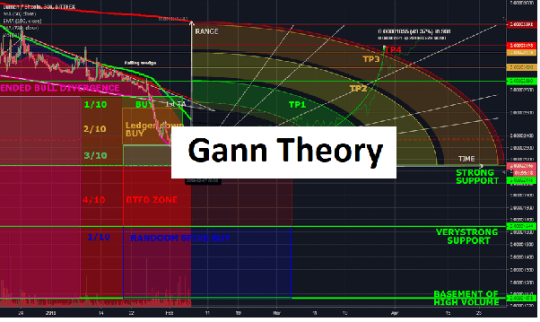
View On WordPress
#Gann Angles#Gann Fans#Gann Square of Nine#Gann&039;s Hexagon#Geometric Patterns#Market Forecasting#Mathematical Principles#Seasonal Changes#technical analysis#Time and Price Squaring#Time Cycles#W.D. Gann
0 notes
Text
Some mathematicians claim they can visualize R^4, or even higher-dimensional spaces. I think this is probably possible for the human mind to do, in principle; the human mind often proves surprisingly flexible. But I think it probably takes a lot of concerted practice, and because you are stretching your mind beyond its intended limits in a purely-internal, imaginative way with no external reference points to check against, I think it probably has some things in common with certain types of meditative practice.
It's also common to hear mathematicians say that if humans had visual intuition for dimensions higher than 3, higher-dimensional geometry may have advanced much farther, since visual intuition is so often crucial in thinking of proofs.
So, ok, I suspect that AI will obviate the utility of this before it could ever have the chance to get off the ground, but this all makes me imagine a world where techniques for learning to visualize higher dimensions are well-known and practiced, and have become a functional necessity for being a working geometer in higher-than-3-dimensions. And these techniques require a lot of persistent practice and training, which (by the nature of the thing) is hard to precisely communicate to students. So part of becoming a geometer involves training in what is basically a meditative practice, where, à la Zen, much of the process involves not directly teaching the student but giving them prompts and mental exercises that are meant to trigger internal, incommunicable revelation. But instead of enlightenment it's geometric intuition. And so if we're getting a math PhD in, say, differential equations or something, it's mostly like it is today. But if your PhD is in low-dimensional topology there's like a whole monastic apprenticeship style thing that just comes along with it. People sometimes drive themselves insane. People sometimes drive themselves insane.
731 notes
·
View notes
Text
Ancient Greek Women Mathematicians you didn't know about

Αίθρα - Aethra (10th - 9th century BC), daughter of the king of Troizina Pitthea and mother of Theseus, knew mathematics in another capacity unknown to many. So sacred to the beginnings of the most cerebral science, Aethra taught arithmetic to the children of Troizina, with that complex awe-inspiring method, since there was no zero… and the numbers were symbolically complex, as their symbols required many repetitions.
Πολυγνώτη - Polygnoti (7th - 6th century BC) The historian Lovon Argeios mentions Polygnotis as a companion and student of Thalis. A scholar of many geometric theorems, it is said in Vitruvius' testimony, that she contributed to the simplification of arithmetic symbols by introducing the principle of acrophony. She managed this by introducing alphabetic letters that corresponded to each in the initial letter of the name of the number. Thus, Δ, the initial of Δέκα (ΤΕΝ), represents the number 10. X, the initial of Χίλια (Thousand), represents the number 1000 etc. According to Vitruvius, Polygnoti formulated and first proved the proposition "Εν κύκλω η εν τω ημικυκλίω γωνία ορθή εστίν" - "In the circle the angle in the hemi-circle is right angle."
Θεμιστόκλεια - Themistoklia (6th century BC). Diogenes the Laertius scholar-writer mentions it as Αριστόκλεια - Aristoclia or Θεόκλεια - Theoclia. Pythagoras took most of his moral principles from the Delphic priestess Themistoclia, who at the same time introduced him to the principles of arithmetic and geometry. According to the philosopher Aristoxenos (4th century BC), Themistoclia taught mathematics to those of the visitors of Delphi who had the relevant appeal. Legend has it that Themistoclia decorated the altar of Apollo with geometric shapes. According to Aristoxenos, Pythagoras admired the knowledge and wisdom of Themistoclia, a fact that prompted him to accept women later in his School.
Μελίσσα - Melissa (6th century BC). Pupil of Pythagoras. She was involved in the construction of regular polygons. Lovon Argeios writes about an unknown work of hers: "Ο Κύκλος Φυσίν - η Μελίσσα - Των Εγγραφομένων Πολυγώνων Απάντων Εστί". (The title translates to "The circle is always the basis of the written polygons" or so.)
Τυμίχα - Tymicha (6th century BC). Thymiha, wife of Crotonian Millios, was (according to Diogenes Laertius) a Spartan, born in Croton. From a very early age, she became a member of the Pythagorean community. Iamblichus mentions a book about "friend numbers". After the destruction of the school by the Democrats of Croton, Tymicha took refuge in Syracuse. The tyrant of Syracuse, Dionysios, demanded that Tymicha reveal to him the secrets of the Pythagorean teaching for a great reward. She flatly refused and even cut her own tongue with her teeth and spat in Dionysius' face. This fact is reported by Hippobotus and Neanthis.
Βιτάλη - Vitali or Vistala (6th – 5th century BC). Vitali was the daughter of Damos and granddaughter of Pythagoras, and an expert in Pythagorean mathematics. Before Pythagoras died, he entrusted her with the "memoirs", that is, the philosophical texts of her father.
Πανδροσίων ή Πάνδροσος - Pandrosion or Pandrossos (4th century AD). Alexandrian geometer, probably a student of Pappos, who dedicates to her the third book of the "Synagogue". Pandrosion divides geometric problems into three categories:" Three genera are of the problems in Geometry and these, levels are called, and the other linear ones."
Πυθαΐς - Pythais (2nd century BC). Geometer, daughter of the mathematician Zenodoros.
Αξιόθεα - Axiothea (4th century BC). She is also a student, like Lasthenia, of Plato's academy. She came to Athens from the Peloponnesian city of Fliounda. She showed a special interest in mathematics and natural philosophy, and later taught these sciences in Corinth and Athens.
Περικτιόνη - Periktioni (5th century BC). Pythagorean philosopher, writer, and mathematician. Various sources identify her with Perictioni, Plato's mother and Critius' daughter. Plato owes his first acquaintance with mathematics and philosophy to Perictioni.
Διοτίμα - Diotima from Mantineia (6th-5th century BC). In Plato's "Symposium", Socrates refers to the Teacher of Diotima, a priestess in Mantineia, who was a Pythagorean and a connoisseur of Pythagorean numerology. According to Xenophon, Diotima had no difficulty in understanding the most complex geometric theorems.

Iamblichos, in his work "On Pythagorean Life", saved the names of Pythagorean women who were connoisseurs of Pythagorean philosophy and Pythagorean mathematics. We have already mentioned some of them. The rest:
Ρυνδακώ - Rynthako
Οκκελώ - Okkelo
Χειλωνίς - Chilonis
Κρατησίκλεια - Kratisiklia
Λασθ��νια - Lasthenia
Αβροτέλεια - Avrotelia
Εχεκράτεια - Ehekratia
Θεανώ - Theano
Τυρσηνίς - Tyrsinis
Πεισιρρόδη - Pisirrodi
Θεαδούσα - Theathousa
Βοιώ - Voio
Βαβέλυκα - Vavelyka
Κλεαίχμα - Cleaihma
Νισθαιαδούσα - Nistheathousa
Νικαρέτη - Nikareti from Corinth
There are so many women whose contribution to science remains hidden. We should strive to find out about more of them! For more information, check out the books of the Greek philologist, lecturer, and professor of ancient Greek history and language, Anna Tziropoulou-Eustathiou.
#I noted those names down from different sources and I copied a few more info from a comment under a video#international women's day#science#history#mathematics#pythagoras#greek women#greek history#hellas#women in stem#women in science#women in mathematics#Pythagorean mathematics#women's history
793 notes
·
View notes
Text
"One of Yonga's personal favourites in the Frame project is Sona or Tusona, an ancient, sophisticated and now rarely used writing system.
It comes from the Chokwe, Luchazi and Luvale people, who live in the borderlands of Angola, the Democratic Republic of Congo and Yonga's own north-western region of Zambia.
Geometric patterns were made in the sand, on cloth and on people's bodies. Or carved into furniture, wooden masks used in the Makishi ancestral masquerade - and a wooden box used to store tools when people were out hunting.
The patterns and symbols carry mathematical principles, references to the cosmos, messages about nature and the environment - as well as instructions on community life.
The original custodians and teachers of Sona were women - and there are still community elders alive who remember how it works.
They are a huge source of knowledge for Yonga's ongoing corroboration of research done on Sona by scholars like Marcus Matthe and Paulus Gerdes.
"Sona's been one of the most popular social media posts - with people expressing surprise and huge excitement, exclaiming: 'Like, what, what? How is this possible?'"
The Queens in Code: Symbols of Women's Power post includes a photograph of a woman from the Tonga community in southern Zambia.
She has her hands on a mealie grinder, a stone used to grind grain.
Researchers from the Women's History Museum of Zambia discovered during a field trip that the grinding stone was more than just a kitchen tool.
It belonged only to the woman who used it - it was not passed down to her daughters. Instead, it was placed on her grave as a tombstone out of respect for the contribution the woman had made to the community's food security.
"What might look like just a grinding stone is in fact a symbol of women's power," Yonga says."
#history#women in history#women's history#zambia#angola#congo#sona#writing systems#women at work#africa#african history#black history#black women in history
116 notes
·
View notes
Note
Hey! Weird request, but do you have prompts for how science and maths could be used in magic scenarios to gain the upper hand and make a battle much easier? So far all I have is using infrared glasses to see an invisible warrior
Science and Math in Magical Battle Scenarios
-> feel free to edit and adjust as you see fit.
Angles of reflection can amplify protective spells. You can design a series of intricate mirrors arranged in a geometric pattern to reflect and amplify your magical shields against an incoming attack.
A sound dampening cloak that absorbs sound waves, making the wearer nearly silent. Using principles of acoustics, the cloak allows the user to sneak up on opponents or escape unnoticed, enhancing stealth tactics during combat.
Sound Waves as Weapons. Combining musical abilities with sound frequency analysis, you can use math to calculate the exact frequency that can disrupt an enemy's concentration or shatter magical barriers, crafting a powerful song that acts as both a weapon and a shield.
A handheld device that scans the environment for various wavelengths of light, allowing the user to see through illusions, detect hidden magical traps, or analyze the composition of materials around them.
Calculating Gravity's Pull. Using physics to modify gravity around a battlefield. By calculating gravitational pull with equations, you can create zones where enemies feel heavy and sluggish, while allies feel lighter and faster, turning the tide of battle.
Using chemistry to concoct volatile mixtures that create spectacular distractions or devastating explosions. By carefully measuring ingredients and employing magical runes, you can cause reactions to target specific enemy units.
Employing concepts from quantum mechanics to create portals that allow you to teleport around the battlefield instantly. By calculating the right coordinates based on your enemies’ positions, you can dodge attacks and reposition themselves strategically.
A small device that releases a swarm of nanobots capable of repairing injuries or armor in real-time. The nanobots can also serve offensive purposes, overwhelming an enemy or disabling their technology.
Light Manipulation. Combine the principles of optics with magic to bend light, creating illusions or cloaking yourself and your allies from view. By understanding how light refracts and reflects, you can create a battlefield advantage by confusing your enemies.
A headset that uses artificial intelligence to analyze an opponent’s movements in real-time. By processing data on their fighting style, it predicts their next moves, providing the user with tactical insights and a chance to counter effectively.
A grenade that emits a short burst of electromagnetic energy, disabling electronic devices and magical constructs in its radius. It could be used to thwart technologically enhanced enemies or disrupt their magical defenses.
#writing prompts#creative writing#writeblr#story prompt#prompt list#ask box prompts#fantasy prompts#sci fi prompt#science and math prompts#battle prompts#fantasy worldbuilding
184 notes
·
View notes
Note
Any tips or guides on how you draw such wonderful mechanical/toy-like characters? It feels robust but not overwhelming, love it.
Thank you! So a lot of it is just knowing how to slap the joints on a normal humanoid body. If you research stuff like figma action figures and real life robots, you'll quickly build up a mental library of mechanical joints that correspond to different body parts. Many things that apply to robots apply to toys and things, though it always depends.

Once you have this library built up, you can kinda just do Whatever. Answered a similar ask a long while back that goes into more detail as well.
Some robots are much more detailed than this though, and the main inspirations I have for Normal Robots in particular are from Portal 2, particularly in Atlas and P-Body; the trick they use is having all the mechanical bits (usually pistons) being colored black and dark-grays, with the shells and casings being white or some other contrasting color.

This is an excellent way of having your cake and getting to eat it as well, because the colored casing draws your eye, and you get rewarded with taking in all the finer mechanical bits without getting distracted by them first.
This main principle is what I use for Kaita, who has mechanical parts, but often shows more subtly in her neck and torso/abdomen.

If you just quickly glanced at this closeup of Kaita from this older bit of art I did here, you'd probably not completely realize she's a robot, but seeing the strange geometric shapes etched into those areas might clue you in. To reiterate: while robots like Kaita are more complicated than toys, they share a good deal of mechanisms for stuff like rotating the arms, turning wrists, etc.
It's also just kinda a character design thing in general, is using strong shape language and going for something... toyetic. Which sounds redundant, but you'd quickly understand what I mean when you look at something like, say, Fortnite characters, or the designs to Ben10 aliens. They're not toys, but they all kinda have that Look to em, and they look like that not just because they do in fact have merchandise, but because that kinda blocky look is really readable, and excellent for action scenes and poses. Just that blocky shape language and strong color-schemes can do a lot of heavy lifting on even the simplest designs.
My main inspirations are Sonic and TF2, which I feel is weirdly obvious when you look at someone like Victor if you look at the blockiness of his body and the way I stick to a limited color palette. As-is he wouldn't fit in either universe visually, but you can kinda see how the design principles bleed into how he looks now.
348 notes
·
View notes
Note
Hey, I wanted to ask, do you have any tips for numbers and their meanings, For example: what does the number 5 represent?
Writing Notes: Symbolism of Numbers
In symbolism, numbers are not merely the expressions of quantities, but idea-forces, each with a particular character of its own.
The actual digits are, as it were, only the outer garments.
All numbers are derived from the number one (which is equivalent to the mystic, nonmanifest point of no magnitude).
The farther a number is from unity, the more deeply it is involved in matter, in the involutive process, in the“world.”
The first 10 numbers in the Greek system (or twelve in the oriental tradition) pertain to the spirit: they are entities, archetypes and symbols.
The rest are the product of combinations of these basic numbers.
Below are the most generally accepted symbolic meanings of each number.
ZERO
Non-being, mysteriously connected with unity as its opposite and its reflection; it is symbolic of the latent and potential and is the “Orphic Egg.”
From the viewpoint of man in existence, it symbolizes death as the state in which the life-forces are transformed.
Because of its circular form, it signifies eternity.
ONE
Symbolic of being and of the revelation to men of the spiritual essence.
The active principle which, broken into fragments, gives rise to multiplicity, and is to be equated with the mystic Centre, the Irradiating Point and the Supreme Power.
Stands for spiritual unity—the common basis among all beings.
Guénon draws a distinction between unity and one, after the Islamic mystic thinkers: unity differs from one in that it is absolute and complete in itself, admitting neither two nor dualism.
Hence, unity is the symbol of divinity.
Is also equated with light.
TWO
Stands for echo, reflection, conflict and counterpoise or contraposition; or the momentary stillness of forces in equilibrium; it also corresponds to the passage of time—the line which goes from behind forward; it is expressed geometrically by two points, two lines or an angle.
It is also symbolic of the first nucleus of matter, of nature in opposition to the creator, of the moon as opposed to the sun.
In all esoteric thought, two is regarded as ominous: it connotes shadow and the bisexuality of all things, or dualism (represented by the basic myth of the Gemini) in the sense of the connecting-link between the immortal and the mortal, or of the unvarying and the varying.
Within the mystic symbolism of landscape in megalithic culture, two is associated with the mandorla-shaped mountain, the focal point of symbolic Inversion, forming the crucible of life and comprising the two opposite poles of good and evil, life and death.
THREE
Symbolizes spiritual synthesis, and is the formula for the creation of each of the worlds.
Represents the solution of the conflict posed by dualism.
Forms a half-circle comprising: birth, zenith and descent.
Geometrically it is expressed by three points and by the triangle.
The harmonic product of the action of unity upon duality.
The number concerned with basic principles, and expresses sufficiency, or the growth of unity within itself.
Associated with the concepts of heaven and the Trinity.
FOUR
Symbolic of the earth, of terrestrial space, of the human situation, of the external, natural limits of the “minimum” awareness of totality, and, finally, of rational organization.
Equated with the square and the cube, and the cross representing the four seasons and the points of the compass.
A great many material and spiritual forms are modelled after the quaternary.
The number associated with tangible achievement and with the Elements.
In mystic thought, it represents the tetramorphs.
FIVE
Symbolic of Man, health and love, and of the quintessence acting upon matter.
Comprises the four limbs of the body plus the head which controls them, and likewise the four fingers plus the thumb and the four cardinal points together with the centre.
The hieros gamos is signified by the number five, since it represents the union of the principle of heaven (three) with that of the Magna Mater (two).
Geometrically, it is the pentagram, or the five-pointed star.
Corresponds to pentagonal symmetry, a common characteristic of organic nature, to the golden section (as noted by the Pythagoreans), and to the five senses representing the five “forms” of matter.
SIX
Symbolic of ambivalence and equilibrium, six comprises the union of the two triangles (of fire and water) and hence signifies the human soul.
The Greeks regarded it as a symbol of the hermaphrodite.
It corresponds to the six Directions of Space (two for each dimension), and to the cessation of movement (since the Creation took six days).
Hence it is associated with trial and effort.
Shown to be related to virginity, and to the scales.
SEVEN
Symbolic of perfect order, a complete period or cycle.
Comprises the union of the ternary and the quaternary, and hence it is endowed with exceptional value.
Corresponds to the seven Directions of Space (that is, the six existential dimensions plus the centre), to the seven-pointed star, to the reconciliation of the square with the triangle by superimposing the latter upon the former (as the sky over the earth) or by inscribing it within.
It is the number forming the basic series of musical notes, of colours and of the planetary spheres, as well as of the gods corresponding to them; and also of the capital sins and their opposing virtues.
Corresponds to the three-dimensional cross.
The symbol of pain.
EIGHT
The octonary, related to two squares or the octagon, is the intermediate form between the square (or the terrestrial order) and the circle (the eternal order) and is, in consequence, a symbol of regeneration.
By virtue of its shape, the numeral is associated with the two interlacing serpents of the caduceus, signifying the balancing out of opposing forces or the equivalence of the spiritual power to the natural.
It also symbolizes—again because of its shape—the eternally spiralling movement of the heavens (shown also by the double sigmoid line—the sign of the infinite).
Because of its implications of regeneration, eight was in the Middle Ages an emblem of the waters of baptism.
Corresponds in mediaeval mystic cosmogony to the fixed stars of the firmament, denoting that the planetary influences have been overcome.
NINE
The triangle of the ternary, and the triplication of the triple.
It is therefore a complete image of the three worlds.
The end-limit of the numerical series before its return to unity.
For the Hebrews, it was the symbol of truth, being characterized by the fact that when multiplied it reproduces itself (in mystic addition).
In medicinal rites, it is the symbolic number par excellence, for it represents triple synthesis, that is, the disposition on each plane of the corporal, the intellectual and the spiritual.
TEN
Symbolic, in decimal systems, of the return to unity.
In the Tetractys (whose triangle of points—four, three, two, one—adds up to ten) it is related to four.
Symbolic also of spiritual achievement, as well as of unity in its function as an even (or ambivalent) number or as the beginning of a new, multiple series.
According to some theories, ten symbolizes the totality of the universe—both metaphysical and material—since it raises all things to unity.
From ancient oriental thought through the Pythagorean school and right up to St. Jerome, it was known as the number of perfection.
ELEVEN
Symbolic of transition, excess and peril and of conflict and martyrdom.
According to Schneider, there is an infernal character about it: since it is in excess of the number of perfection—ten—it therefore stands for incontinence; but at the same time it corresponds, like two, to the mandorla-shaped mountain, to the focal point of symbolic Inversion and antithesis, because it is made up of one plus one (comparable in a way with two).
TWELVE
Symbolic of cosmic order and salvation.
It corresponds to the number of the signs of the Zodiac, and is the basis of all dodecanary groups.
Linked to it are the notions of space and time, and the wheel or circle.
THIRTEEN
Symbolic of death and birth, of beginning afresh.
Hence it has unfavourable implications.
FOURTEEN
Stands for fusion and organization.
And for justice and temperance.
FIFTEEN
Markedly erotic.
Associated with the devil.
OTHER NUMBERS
Tarot
Each of the numbers from sixteen to twenty-two is related to the corresponding card of the Tarot pack; and sometimes the meaning is derived from the fusion of the symbols of the units composing it.
There are two ways in which this fusion may occur: either by mystic addition (for example, 374 = 3 + 7 + 4 = 14 = 1 + 4 = 5) or by succession, in which case the right-hand digit expresses the outcome of a situation denoted by the left-hand number (so 21 expresses the reduction of a conflict—two—to its solution—unity).
These numbers also possess certain meanings drawn from traditional sources and remote from their intrinsic symbolism:
24, for example, is the sacred number in Sankhya philosophy, and
50 is very common in Greek mythology—there were fifty Danaides, fifty Argonauts, fifty sons of Priam and of Aegyptus, for example as a symbol, we would suggest, of that powerful quality of the erotic and human which is so typical of Hellenic myths.
Repetition
The repetition of a given number stresses its quantitative power but detracts from its spiritual dignity.
So, for example, 666 was the number of the Beast because 6 was regarded as inferior to seven.
Contained within a multiple
When several kinds of symbolic meaning are contained within a multiple number, the symbolism of that number is accordingly enriched and strengthened.
Thus, 144 was considered very favourable because its sum was 9 (1 + 4 + 4) and because it comprises multiples of 10 and 4 plus the quaternary itself.
Lastly: Dante, in the Divine Comedy, has frequent recourse to the symbolism of numbers.
Sources: 1 2 3
More: On Symbolism
Hope this helps, would love to read your writing if it does!
#symbolism#writing reference#dark academia#spilled ink#writeblr#writing prompts#literature#writers on tumblr#poets on tumblr#writing prompt#poetry#creative writing#numbers#light academia#fiction#novel#booklr#bookblr#writing resources
195 notes
·
View notes
Text
It took about two hours for Daina Taimina to find the solution that had eluded mathematicians for over a century. It was 1997, and the Latvian mathematician was participating in a geometry workshop at Cornell University. David Henderson, the professor leading the workshop, was modelling a hyperbolic plane constructed out of thin, circular strips of paper taped together. 'It was disgusting,' laughed Taimina in an interview.
A hyperbolic plane is 'the geometric opposite' of a sphere, explains Henderson in an interview with arts and culture magazine Cabinet. 'On a sphere, the surface curves in on itself and is closed. A hyperbolic plane is a surface in which the space curves away from itself at every point.' It exists in nature in ruffled lettuce leaves, in coral leaf, in sea slugs, in cancer cells. Hyperbolic geometry is used by statisticians when they work with multidimensional data, by Pixar animators when they want to simulate realistic cloth, by auto-industry engineers to design aerodynamic cars, by acoustic engineers to design concert halls. It's the foundation of the theory of relativity, and thus the closest thing we have to an understanding of the shape of the universe. In short, hyperbolic space is a pretty big deal.
But for thousands of years, hyperbolic space didn't exist. At least it didn't according to mathematicians, who believed that there were only two types of space: Euclidean, or flat space, like a table, and spherical space, like a ball. In the nineteenth century, hyperbolic space was discovered - but only in principle. And although mathematicians tried for over a century to find a way to successfully represent this space physically, no one managed it - until Taimina attended that workshop at Cornell. Because as well as being a professor of mathematics, Taimina also liked to crochet.
Taimina learnt to crochet as a schoolgirl. Growing up in Latvia, part of the former Soviet Union, 'you fix your own car, you fix your own faucet - anything', she explains. 'When I was growing up, knitting or any other handiwork meant you could make a dress or a sweater different from everybody else's.' But while she had always seen patterns and algorithms in knitting and crochet, Taimina had never connected this traditional, domestic, feminine skill with her professional work in maths. Until that workshop in 1997. When she saw the battered paper approximation Henderson was using to explain hyperbolic space, she realised: I can make this out of crochet.
And so that's what she did. She spent her summer 'crocheting a classroom set of hyperbolic forms' by the swimming pool. 'People walked by, and they asked me, "What are you doing?" And I answered, "Oh, I'm crocheting the hyperbolic plane."' She has now created hundreds of models and explains that in the process of making them 'you get a very concrete sense of the space expanding exponentially. The first rows take no time but the later rows can take literally hours, they have so many stitches. You get a visceral sense of what "hyperbolic" really means.' Just looking at her models did the same for others: in an interview with the New York Times Taimina recalled a professor who had taught hyperbolic space for years seeing one and saying, 'Oh, so that's how they look.' Now her creations are the standard model for explaining hyperbolic space.
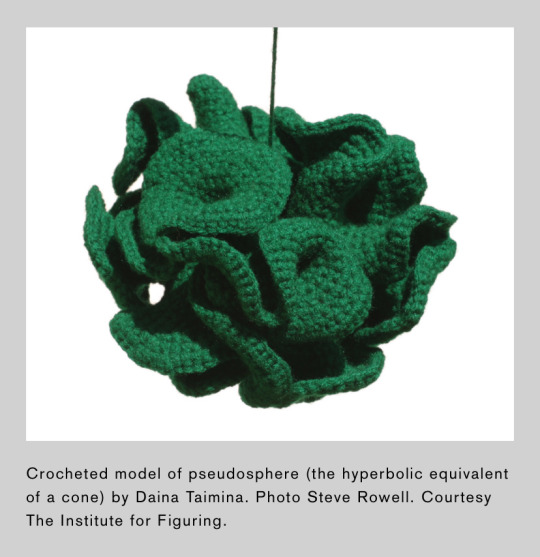
-Caroline Criado Perez, Invisible Women
Photo credit
#caroline criado perez#Daina Taimina#women in stem#women’s history#women in science#crochet#crocheting#female mathematicians#hyperbolic space
389 notes
·
View notes
Text
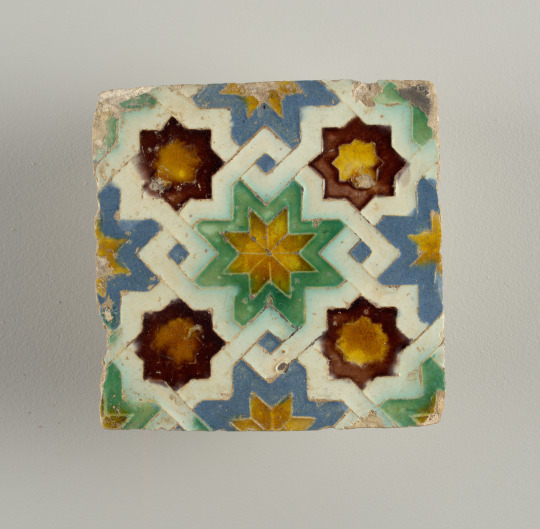



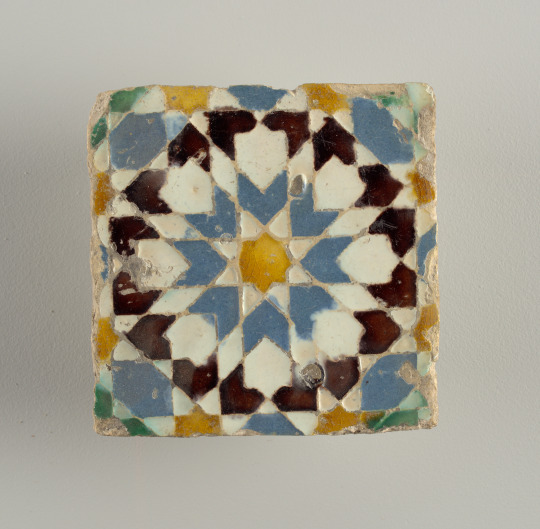
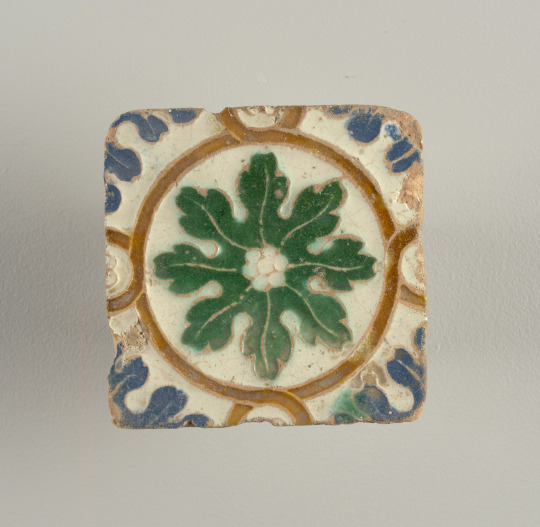

Tile(s) (Spain), 16th. century. Glazed moulded earthenware .
Likely dating from the early to mid sixteenth century, this tile illustrates Spain’s rich multicultural design history. Spain’s remarkable decorative pottery tradition originated during the eighth century when the country was conquered by the Moorish Muslim troops of North Africa as part of the expansion of the Umayyad Caliphate. This sixteenth-century tile shows how influential Islamic design principles were on Spanish pottery, even after the Reconquista—the period of the Moors conquest to their dethronement in the fifteenth century. The sixteenth century was also a time of transition for Spanish pottery. One can identify the influences of Flemish and Italian immigrants to Renaissance ideas and the continual impact of the country’s remaining Muslim population on Spanish pottery design. [1]
The white interlace motif on this tile creates a pattern of diamonds centered on an eight-pointed star in green and yellow. Strong color contrasts make the tile visually striking. This tile would have been one of countless others used to decorate a wall or ceiling in order to create an abstract and complex geometric pattern. Geometric patterning is a key visual element of Islamic art as one of three types of non-figural decoration along with calligraphic and vegetal patterns.
Although stylistically diverse, the visual complexity of all-over patterning is also seen in Spanish lustreware (referred to as Hispano-Moresque ware) and textiles from this period. This preference for all-over patterning can in part be attributed to Spanish decorative art’s intimate relationship with Islamic art and culture. In addition, this is the period when the country’s colonisation of the Americas further enriched Spain’s cultural complexity as is mirrored in both Spanish and Mexican Talavera pottery.
https://collection.cooperhewitt.org
90 notes
·
View notes
Text

Metatron's Cube: A Symbol of Cosmic Geometry and Modern Art Historical Origins The origins of Metatron's Cube can be traced back to ancient texts and beliefs. The name "Metatron" is derived from the Hebrew Bible, where Metatron is described as an angelic scribe and intermediary between God and humans. The cube itself is a two-dimensional representation of a three-dimensional shape known as a "Metatron's Cube" or "Metatron's Cube Octahedron." It is composed of 13 circles (nodes) interconnected by straight lines, forming a symmetrical and harmonious pattern. One of the earliest known references to Metatron's Cube is found in the Kabbalah, a Jewish mystical tradition. In the Kabbalah, it is believed that Metatron's Cube represents the structure of the universe and the divine blueprint of creation. Each of the 13 circles within the cube is associated with an archangel, and the lines connecting them symbolize the paths that these angels use to communicate with one another and with the divine. Mathematics and Sacred Geometry Metatron's Cube is not only a symbol of spirituality but also a masterpiece of sacred geometry. It embodies several mathematical principles, including the Fibonacci sequence and the Golden Ratio. The Fibonacci sequence is a series of numbers where each number is the sum of the two preceding ones (e.g., 0, 1, 1, 2, 3, 5, 8, 13, 21...), and the Golden Ratio (approximately 1.61803398875) is a mathematical constant that appears in various aspects of nature and art. This geometric masterpiece is not limited to any single religion or culture. It transcends boundaries and is embraced by individuals from different spiritual backgrounds and worldviews. Metatron's Cube is a testament to the universal appeal of geometry and its ability to inspire awe and wonder.
69 notes
·
View notes
Note
Hii! You fucking ate with the TDI redesigns and it wanted to know if you'd make a guide as to how you mimicked the TDI style?
hihi !! tysm !! glad a lot of ppl like em !!
as for the style guide, i am far from an expert at replicating art styles, but having a neo-UPA inspired art style really made this easier for me, even if i did struggle on getting used to some design choices.
DISCLAIMER: I do not condone tracing over other people’s artwork to claim as your own final product. I only trace the shapes from the total drama characters to break down and analyze the art style for educational purposes.
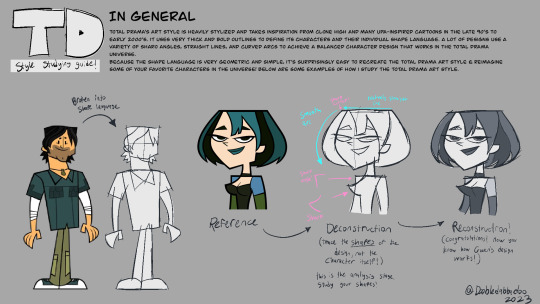
IN GENERAL
total drama’s art style is heavily stylized and takes inspiration from clone high and many UPA-inspired cartoons in the late 90’s to early 2000’s. it uses very thick and bold outlines to define its characters and their individual shape language. a lot of designs use a variety of sharp angles, straight lines, and curved arcs to achieve a balanced character design that works in the total drama universe.
because the shape language is very geometric and simple, it’s surprisingly easy to recreate the total drama art style & reimagine some of your favorite characters in the universe!

BODY TYPES: THE “TYPICAL” WOMAN
a lot of the women in the show follow this base, even more than the “typical” male body type. compared to the men, the women of total drama have cat-like eyes, stylized lips, skinny necks, an hour-glass figure, longer and thicker legs, and pointy fingers. head shapes & features may vary depending on character and/or ethnicity. not all women in the show look like this, though! there’s a decent handful of women with very unique body types, such as beth, macarthur, & emma from the 2023 reboot! it also helps to reference characters from different seasons to get a better idea of the shape language in the show’s universe!

BODY TYPES: THE “TYPICAL” MAN
the “typical” body type for men isn’t as well defined as it is for the “typical” woman, so there aren’t as many examples of what defines the “typical” male body type. However, based on the handful of characters we collected, we can determine that the “typical” male body type in total drama is top-heavy. compared to the women, many of the men have broad chests and shoulders, thicker and longer arms, thicker necks, thinner waists and hips, and shorter, thinner legs. they have flatter, more boxy fingers comoared to the pointy fingers the women have. head shapes and features may vary depending on character and/or ethnicity.
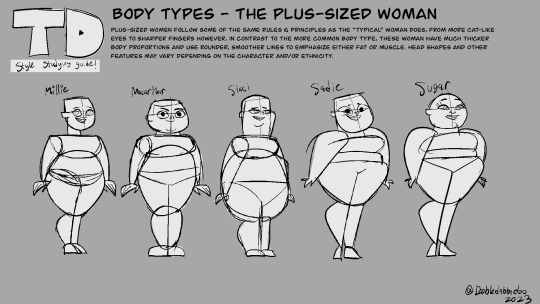
BODY TYPES: THE PLUS SIZED WOMAN
plus-sized women follow some of the same rules & principles as the “typical” woman does, from more cat-like eyes to sharper fingers however, in contrast to the more common body type, these woman have much thicker body proportions and use rounder, smoother lines to emphasize either fat or muscle. head shapes and other features may vary depending on the character and/or ethnicity.

BODY TYPES: THE PLUS SIZED MAN
there’s a pretty good variety when it comes to drawing plus-sized men. while some of them, like ripper, follow some similar principles to the “typical” man, others offer a new, unique design base to work with. their features are generally rounder and wider to emphasize their weight. head shapes & other features may vary depending on character and/or ethnicity.
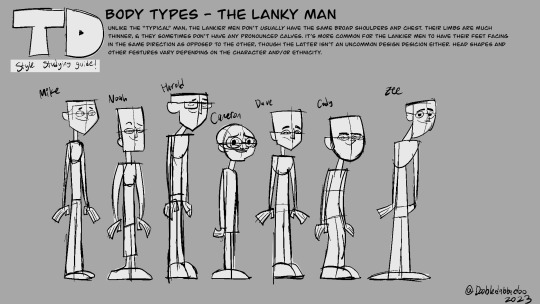
BODY TYPES: THE LANKY MAN
unlike the “typical” man, the lankier men don’t usually have the same broad shoulders and chest. their limbs are much thinner, & they sometimes don’t have any pronounced calves. it’s more common for the lankier men to have their feet facing in the same direction as opposed to the other, though the latter isn’t an uncommon design desicion either. head shapes and other festures vary depending on the character and/or ethnicity.
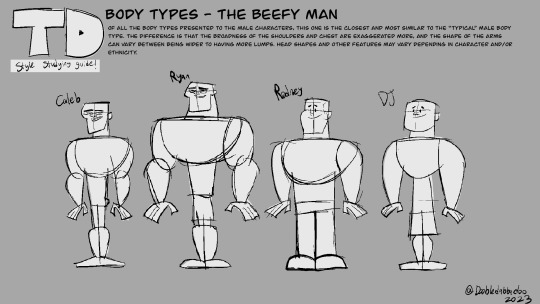
BODY TYPES: THE BEEFY MAN
Of all the body types presented to the male characters, this one is the closest and most similar to the “typical” male body type. the difference is that the broadness of the shoulders and chest are exaggerated more, and the shape of the arms can vary between being wider to having more lumps. head shapes and other features may vary depending in character and/or ethnicity.
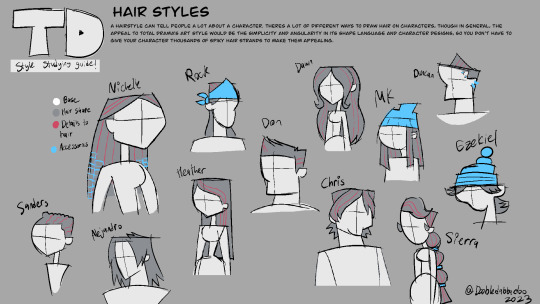
HAIR STYLES
a hairstyle can tell people a lot about a character. theres a lot of different ways to draw hair on characters, though in general, the appeal to total drama’s art style would be the simplicity and angularity in its shape language and character designs, so you don’t have to give your character thousands of spiky hair strands to make them appealing.
im not good at explaining how i replicate art styles so i really hope these help!!! also im sorry this ask took forever to compile lol i just wanted an excuse to study the shows art style more. heres another helpful video to help understand the process of character design !!
youtube
i also recommend checking out harry gold’s channel. he does a lot of art style replication videos & this one explains art style replication exceptionally well!
youtube
tysm for ur ask & tysm for ur patience!!
#dooble moment#idk ask dooble#my art#total drama#long post#reference#hhhhhhgh i really hope this helps#i struggled to communcate this for a while & college is a nightmare when it comes to finding freetime#anyways#more total drama stuff WHEEEEEEEE!!!#art tips#art reference
858 notes
·
View notes
Text
The Platonic Solids

Tetrahedron, hexahedron (cube), octahedron, dodecahedron, and icosahedron-are central to sacred geometry and spiritually embody balance and symmetry. Each solid is linked to the classical elements- Earth, Air, Fire, Water, and Ether- highlighting the interconnectedness of the Universe. These shapes represent more than mere mathematical interest; they symbolize the fundamental principals that orchestrate the Universe. There are profound meanings attributed to the Platonic solids within sacred geometry and spirituality.
History And Origins
• Ancient Greece-The birthplace of the Platonic solids: The exploration of sacred geometry can be traced back to the influential mathematician Pythagoras (570-495BC). His school of thought laid the foundations for later philosophers to build upon. However, it was the renowned Greek philosopher Plato (427-347BC) who popularized the term "Platonic solids". Although he was not the first to study these shapes, his work was pivotal in their widespread recognition. In his masterpiece 'Timaeus', Plato assigned each soldid to one of the four classical elements, Fire (tetrahedron), Earth (hexahedron), Air (Octahedron), and Water (icosahedron). In later interpretations and writings the fifth Platonic solid, the dodecahedron, was associated with the element of Ether (also called Quintessence or Spirit).
• Euclid's Elements: One cannot discuss the history of Platonic solids without mentioning Euclid (~300BC), known as the Father of Geometry. His groundbreaking work 'Elements' outlined rigorous proofs for each solid shape's properties, forever cementing their place in mathematics. These expanded our knowledge of Platonic solids and helped establish a solid foundation in mathematics for future generations.
• Archimedes' Influence: Although not directly related to Platonic solids, Archimedes (~287-212BC) expanded upon their concepts by discovering thirteen semi-regular shapes known as the Archimedean solids. These are a collection of thirteen shapes which share certain characteristics with the Platonic solids. This work demonstrated that geometric principles extended beyond the five Platonic solids, further enriching our understanding of sacred geometry.

Unique Characteristics
The five Platonic solids have distinct characteristics that define them, making them the cornerstone of sacred geometry. The key defining features are:
• All faces are congruent regular polygons (equalateral triangles, squares, or pentagons).
• Each vertex (corner) connects and equal number of edges.
• They are symmetrical structures- rotation of reflection can interchange any two vertices.
These attributes result in only five possible shapes that meet these criteria: tetrahedron, hexahedron, octahedron, dodecahedron, and icosahedron. Each solid has its unique symbolism and spiritual significance that has been recognized across various cultures and ancient traditions.
The Tetrahedron
The tetrahedron, also known as a triangular pyramid, is the simplest of the Platonic solids. It represents embodying the principles of energy, passion, and transformation and the chaos of Fire.

• Geometric properties: The tetrahedron has four vertices, six edges, and four faces, all of which are equalateral triangles. It's the only Platonic solid that does not have parallel faces, giving it a sense of directionality and movement.
• Associated element: Fire
• Associated chakra: Solar Plexus
• Spiritual meaning: The tetrahedron is associated with personal power, creativity, and the drive for change. It symbolizes the dynamic and transformative nature of fire, representing the ability to purify, illuminate and transmute.
• Uses: The tetrahedron is used for focusing intentions, manifesting desires, facilitating personal transformation. It is also employed in meditation and energy work to enhance one's inner fire and to promote balance and harmony within the self.
The Hexahedron
The hexahedron, commonly known as a cube, represents the element of Earth in the Platonic solids. It symbolizes stability, solidity, and groundedness.

• Geometric properties: The hexahedron has eight vertices, twelve edges, and six faces, all of which are squares. Its equal sides and angles provide a sense of balance and symmetry.
• Associated element: Earth
• Associated chakra: Root
• Spiritual meaning: The hexahedron symbolizes stability, reliability, and the functional aspects of life. It is associated with the material world and a strong connection to to the earth.
• Uses: The hexahedron can be used for grounding, centering, and connecting to the physical realm. It is often employed in meditation to foster a sense of security and stability.
The Octahedron
The octahedron represents the element of air. It is associated with balance, communication, and intellectual pursuits.

• Geometric properties: The octahedron has six vertices, twelve edges, and eight faces, all of which are equalateral triangles. Its a dual polyhedron to the hexahedron, reflecting a balance between the physical and the mental.
• Associated element: Air
• Associated chakra: Heart, Throat
• Spiritual meaning: The octahedron symbolizes harmony, balance, and integration. It's associated with the breath of life and the floe of energy, representing mental clarity and intellectual growth.
• Uses: The octahedron is used to enhance communication, foster understanding, and promote a sense of harmony it is used in meditation to balance emotions and thoughts.
The Icosahedron
The icosahedron represents the element of Water. It symbolizes adaptability, flow, and emotional intelligence.

• Geometric properties: The icosahedron has twelve vertices, thirty edges, and twenty faces, all of which are equalateral triangles. Its many faces and edges give it a spherical appearance, suggesting fluidity and movement.
• Associated element: Water
• Associated chakra: Sacral
• Spiritual meaning: The icosahedron is associated with the flow of emotions, adaptability, and creativity. It symbolizes thr ever-changing nature of water and the ability to navigate through life's challenges with grace.
• Uses: The icosahedron is used to enhance emotional expression, activate sexuality, facilitate change, and promote connections. It's employed in meditation to connect with the fluid aspects of the self.
The Dodecahedron
The dodecahedron represents Ether, Spirit, or the Universe. It symbolizes the interconnectedness of all things and the mystery of the cosmos.

• Geometric properties: The dodecahedron has twenty vertices, thirty edges, and twelve faces, all of which are pentagons. Its complex shape suggests a connection to the divine and the unknown.
• Associated element: Ether(Spirit)
• Associated chakra: Third Eye, Crown
• Spiritual meaning: The dodecahedron is associated with the Universe, divine creation, and the interconnectedness of all beings. It symbolizes the mystery of existence and the exploring deeper levels of consciousness.
• Uses: The dodecahedron can be used to connect with the higher realms, enhance spiritual awareness, and promote a sense of unity. It is used in meditation to explore tge mysteries of the universe and the self.

#sacred geometry#platonic#Plato#magick#witch#esoteric#occultism#occulltism#occult#meditation#chaos#ancient greece#healing#astral#spiritual journey#spirit work#eclectic#pagan#witch community#witchblr#dark#witchcraft#lefthandpath#satanic witch#satanism#sacred#geometry#geometric
92 notes
·
View notes